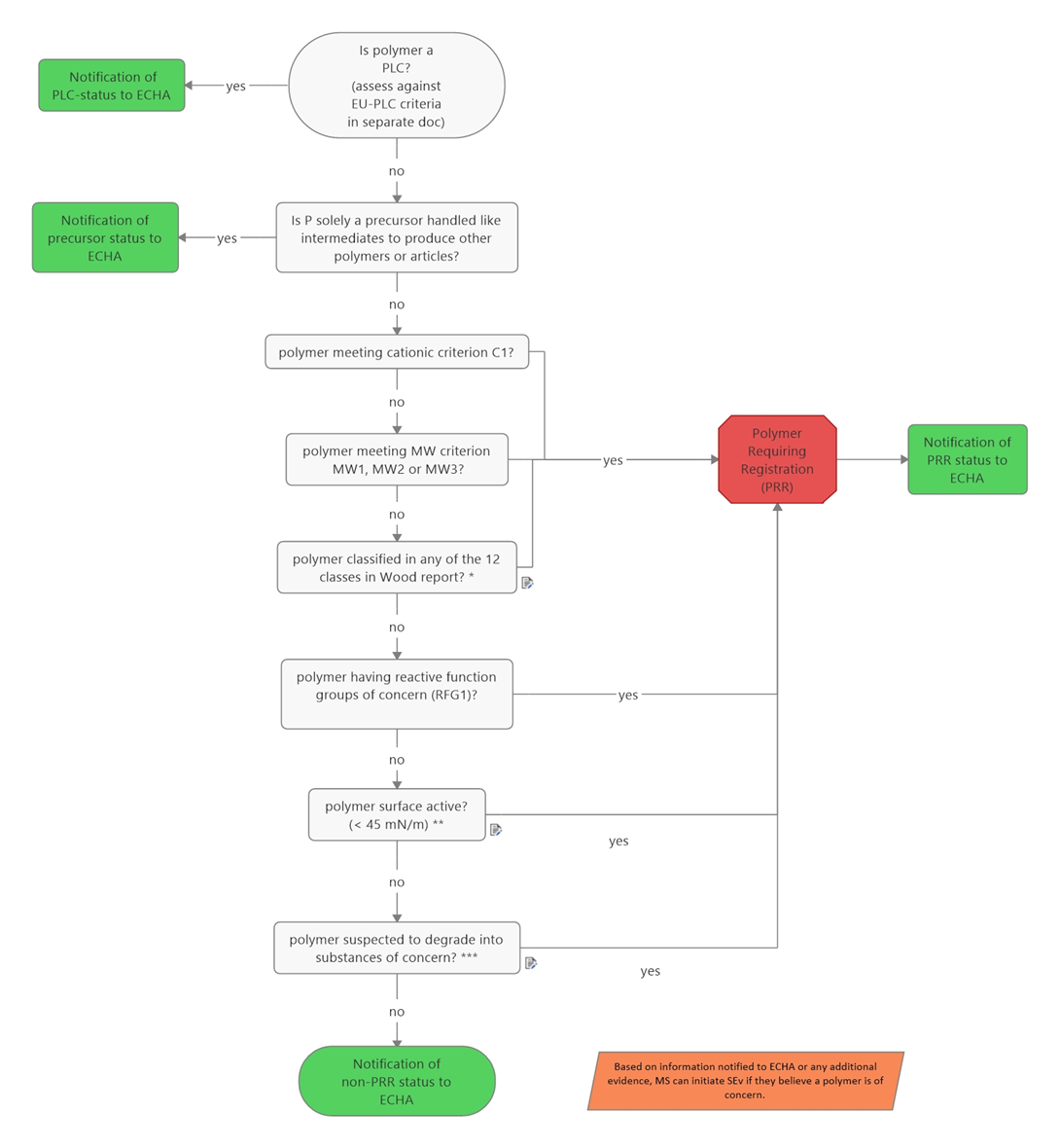- REACH
- CLP
- COSMETICS
- ADR
- PMC
- BIOCIDES
- DETERGENT AND CLEANING PRODUCTS
- SAFE & SUSTAINABLE
- CAM
- ENVIRONMENTAL LABELLING
- ECOLABEL
- WASTE SORTING LABELLING
- SINGLE USE PLASTICS
- GLOBAL RECYCLE STANDARD
- REMADE IN ITALY
- COMPOSTABILE
- VENDITE ON LINE
- FOOD DIETARY SUPPLEMENTS
- EXPLOSIVES PRECURSORS
- PIC
- ReMaF
- FOOD CONTACT MATERIALS
- Training
- News
Polymers
According to REACH ( art 3, 5) a Polymer is a substance meeting the following criteria:
(a) Over 50 percent of the weight for that substance consists of polymer molecules ; and,
(b) The amount of polymer molecules presenting the same molecular weight must be less than 50 weight percent of the substance.
The preferred method to determine whether a substance falls under the definition of a polymer is Gel Permeation Chromatography (GPC). acording to OECD TG 118 (1996).
Polymers are exempt from the REACH registration obligation (Article 2, paragraph 9).
According to Article 6(3), the manufacturer or importer of a polymer must however submit a registration to the Agency for the monomer substance(s) or any other substance(s) that have not already been registered by an actor up the supply chain, if both the following conditions are met:
(a) the polymer consists of 2% weight by weight (w/w) or more of such monomer substance(s) or other substance(s) in the form of monomeric units and chemically bound substance(s);
(b) the total quantity of such monomer substance(s) or other substance(s) makes up 1 tonne or more per year (the total quantity in this context is the total quantity of monomer or other substance ending up chemically bound to the polymer).
CHANGING THE REACH REGULATION : REGISTRATION OF POLYMERS
REACH does not currently require registration or evaluation of polymers, but under Article 138(2) the Commission is required to review the risks they pose and the need for registration of certain types of polymers.
On July 2020 a final report has been published from consultancy groups Wood and Peter Fisk Associates (PFA). A summary of its key findings, including criteria for selecting polymers for registration, were outlined to the Competent Authorities for REACH and CLP.
The gals are
- Propose criteria for the identification of PRRs (polymers requiring registration), including the possibility of grouping PRRs, based on physicochemical properties and/or indication of hazard.
- Estimate the potential risks to human health and the environment posed by PRRs in comparison with other substances.
- Test and validate assumptions in a workshop.
- Provide a detailed cost-benefit analysis of the registration requirements that could be used by the Commission in a subsequent impact assessment. A series of testing strategies are proposed that enable an initial assessment. The results will indicate which further tests are relevant to derive a meaningful chemical safety assessment based on the polymer properties.
The report sets out a possible approach to grouping of polymers. Most current approaches to grouping are based on similarity of hazards and similarity of exposure or use.
Two main types of grouping of polymers are identified:
- Grouping to identify which polymers meet the criteria for ‘polymers requiring registration’, and to allow the manufacturers/importers of similar types of PRR to consider future collaboration on registration; and
- Grouping of polymers in relation to the specific registration requirements, in order to facilitate cost-effective registration of PRR in line with the ‘one substance, one registration’ principle and to reduce testing costs and avoid unnecessary testing (e.g. through read-across of data).

NOTES:
* THE 12 HAZARD CLASSES: (ACUTE TOX. 1 TO ACUTE TOX. 4); (MUTA. 1A, MUTA. 1B OR MUTA. 2); (CARC. 1A, CARC. 1B OR CARC. 2); (REPR. 1A, REPR. 1B, REPR. 2 OR LACT.); (ASP. TOX. 1 ); (RESP. SENS. 1, 1A OR 1B); (SKIN SENS. 1, 1A OR 1B); (STOT SE1 TO SE3); (STOT RE 1 AND STOT RE 2); (EYE DAM. 1 OR SKIN CORR. 1, 1A, 1B OR 1C); (AQUATIC ACUTE 1, AQUATIC CHRONIC 1 TO 4); (OZONE). UNDER THE CHEMICALS STRATEGY, WORK IS ONGOING TO ADD NEW HAZARD CLASSES TO CLP FOR SUBSTANCES THAT ARE ED, PBT, VPVB, PMT AND VPVM. ONCE THOSE NEW CLASSES FOR CRITICAL HAZARDS HAVE BEEN ADDED TO CLP, THEY WOULD ALSO BE ADDED TO THE HAZARD CLASSES WHICH WOULD MAKE A POLYMER A PRR.
** SURFACE ACTIVITY CRITERION COVERS ANIONIC, NON-IONIC AND AMPHOTERIC POLYMERS.
*** SUBSTANCES OF CONCERN: STILL TO BE DEFINED.
The criteria for defining the “Low Concern polymers - PLC”, still under discussion, are based on
- MOLECULAR WEIGHT (MW - molecular weight)
- FUNCTIONALITY (RFG - Reactive Functional Groups / FGEW - Functional Group Equivalent Weight)
- CLP - Hazard classification
- FEATURES - Ionicity, degradation
- SPECIFIC CLASSES -. Polyesters, Fluoropolymers